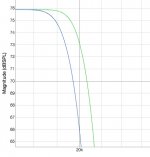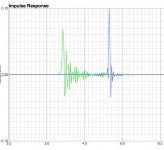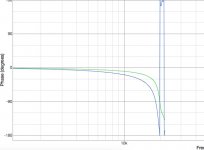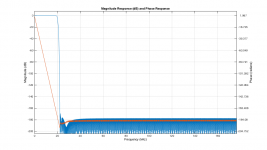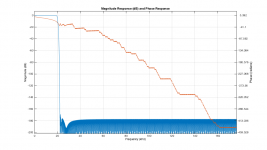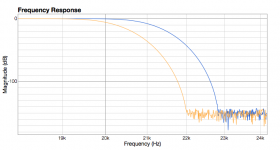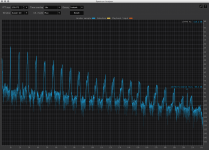NQ1008 has some brightness (sibilance) in it, which might be attractive first but compared to the steeper filters sounds somehow wrong. Are these imaging artefacts?
It's a bit hard to pin down the exact cause but I think imaging is the most likely cause. There seems to be low level spikes between the harmonics that increase as the roll-off extends to higher frequencies.
Given the popularity of slow roll-off there is clearly a way to balance the harshness - it may be that early roll-off takes the edge off as with NOS.
A very quick listen... I often thought 384_C130 about right, and I feel somewhat more open than 1013_C180 above. Some may argue 384 is 'too bright' however, while 1013 is 'more balanced'. Everything is there yet no one thing jumps out at you. I agree with the comments above about percussive sounds wrt 384, perhaps because it tends towards being 'brighter' and more open, which likely explains why some may find the bass lacking. I'm tending towards 1013, although still like 384. Sox_fixup has many of the qualities of 384 & 1013, on balance however, I'm favouring 1013 as I think it gives a greater sense of scale front to back and arguably more space around the instruments - trying some James Last, of all things!
Paul, I'm finding your filters today are all very good such the differences between them are almost non-extent, to my ears at least. I have a folder with four 'benchmark' filters, New_NOS, Sox_fixup, 384_C130, NQ_C960_140dp, think I'll add 1013_C180_BW. Having said they are all very good, there appears to be something about one every now and again which promotes it to my benckmarh folder.
Thanks, Andrew
Paul, I'm finding your filters today are all very good such the differences between them are almost non-extent, to my ears at least. I have a folder with four 'benchmark' filters, New_NOS, Sox_fixup, 384_C130, NQ_C960_140dp, think I'll add 1013_C180_BW. Having said they are all very good, there appears to be something about one every now and again which promotes it to my benckmarh folder.
Thanks, Andrew
Paul, I'm finding your filters today are all very good such the differences between them are almost non-extent, to my ears at least. I have a folder with four 'benchmark' filters, New_NOS, Sox_fixup, 384_C130, NQ_C960_140dp, think I'll add 1013_C180_BW. Having said they are all very good, there appears to be something about one every now and again which promotes it to my benckmarh folder.
Thanks, Andrew
Thank you, Andrew.
I agree the differences are getting pretty small but they are still there. I had to go back and compare with the stock filters because I was starting to wonder if I was just imagining differences

There is a clear difference between the 384_C130 and the recent 1013_C180 (which is really C170 but was misnamed). Switching between the two you can immediately hear the shift in perspective of the highs - they jump forward slightly and sound a little more extended in the 384.
I'm listening to a 1013_C170_MP at the moment (keeping in mind that the C180 is actually C170). It's interesting in that the Linear phase version sounds drier. I get the sense the MP versions are a bit like turning up the "space reverb" effect. It gives a nice sense of ambience but my impression is that you need to shorten the ringing with MP to avoid over hyping the effect.
Oddly you notice it more when you switch back to the LP than being immediately noticeable going the other way.
I've attached the MP version seeing I've rambled on about how it sounds...
Attachments
Thank you, Andrew.
I agree the differences are getting pretty small but they are still there. I had to go back and compare with the stock filters because I was starting to wonder if I was just imagining differences
There is a clear difference between the 384_C130 and the recent 1013_C180 (which is really C170 but was misnamed). Switching between the two you can immediately hear the shift in perspective of the highs - they jump forward slightly and sound a little more extended in the 384.
I'm listening to a 1013_C170_MP at the moment (keeping in mind that the C180 is actually C170). It's interesting in that the Linear phase version sounds drier. I get the sense the MP versions are a bit like turning up the "space reverb" effect. It gives a nice sense of ambience but my impression is that you need to shorten the ringing with MP to avoid over hyping the effect.
Oddly you notice it more when you switch back to the LP than being immediately noticeable going the other way.
I've attached the MP version seeing I've rambled on about how it sounds...
I just want to thank you for not just focusing on the 384 filter that other's like. The staging of your other filters appeal much more to me. Will give this a go soon!
Just compared 1013 180 LP vs 1013 170 MP and I am surprised that I like the Minimal Phase filter better than the Linear phase one. There seems to be a better soundstage with the MP filter, things get a bit more emotional for me. And the body of the instruments are more pronounced. As always it could be some kind of enhancement going on, but I like it.
But there seems to go on more that just a switch from LP to MP, if you look at the attachments you see that frequency and phase response differ quite a bit.
MP rings a lot though, I would love to try some intermediate filter with those settings.
But there seems to go on more that just a switch from LP to MP, if you look at the attachments you see that frequency and phase response differ quite a bit.
MP rings a lot though, I would love to try some intermediate filter with those settings.
Attachments
But there seems to go on more that just a switch from LP to MP, if you look at the attachments you see that frequency and phase response differ quite a bit.
Yep. I'd been messing around checking to see the effect of Søren's proposed tap length increase, and altered some other settings...
Phase response will be completely different - one is minimum phase, the other is linear after all.
Saving settings is a bit hit and miss in Slifer so I've redone the base filter and made a MP directly from that.
Attachments
Last edited:
I've redone the base filter and made a MP directly from that.
Response/Phase for the 1013_C180 filters.
LP:
MP:
Attachments
Yesterday I was listening to the 1021filt_1013_C180_BW filter, which I believe is the best filter so far. The metallic highs of the 1016_K180 are gone, but the impressive and holographic stage is still there, with nice impact and energy in the bass region. So this is my benchmark filter. Unfortunately I am out of testing filters for a while, although I am really curious about the new MP version. It seems that the current filters of Paul where so good and non distorting, that I was driving too hard my amp. So today there was smoke from the PSU of my truepath. I hope that the damage is not extensive.
It seems that the current filters of Paul where so good and non distorting, that I was driving too hard my amp. So today there was smoke from the PSU of my truepath. I hope that the damage is not extensive.
Ouch!!
Hope it's easy/cheap to get back in service. I always look forward to reading your comments on the filters.
The latest filters indeed tempt you to turn the volume up ... which results, at dynamic peaks, to a volume which gets probably close to being unhealthy (headphones) .
However in such situations the 1013_C180 is only very loud, whereas the 1013_C180_MP adds something like a pressure to the ear which is unpleasant.
I have the impression that the SoX_fixup_HiAtt gives slightly more details than the 1013_C180, but that could perhaps also be a slight difference in gain.
However in such situations the 1013_C180 is only very loud, whereas the 1013_C180_MP adds something like a pressure to the ear which is unpleasant.
I have the impression that the SoX_fixup_HiAtt gives slightly more details than the 1013_C180, but that could perhaps also be a slight difference in gain.
I just want to thank you for not just focusing on the 384 filter that other's like. The staging of your other filters appeal much more to me. Will give this a go soon!
Thanks. I'm basically exploring the possibilities available trying to get the best balanced sound. That said, the steep filters which attenuate at fs/2 are sounding particularly good imo.
I have the impression that the SoX_fixup_HiAtt gives slightly more details than the 1013_C180, but that could perhaps also be a slight difference in gain.
Possibly it's down to gain.
The SoX filter runs over fs/2 by 7-800Hz which allows it to remain flat to over 20kHz, whereas the C180 is down by 6dB at 20kHz, although I doubt the flat response to 20+kHz is making much difference.
I've done a test filter that is has 140dB stop band attenuation at 22.05kHz, which has the effect of reducing roll-off to -2dB at 20kHz. I don't hear any appreciable difference in detail between the two non-SoX two filters. Yet the SoX filter is noticeably brighter.
The Log Squared response of the SoX HiAtt and C180 is virtually identical in shape, so nothing there that would indicate a reason for these apparent differences.
Attachments
Last edited:
The most "obvious" difference was at a violin solo when playing a very long single (moderately high) note not too loud. Perhaps the different filter response had a influence on the balance of the harmonics.The SoX filter runs over fs/2 by 7-800Hz which allows it to remain flat to over 20kHz, whereas the C180 is down by 6dB at 20kHz, although I doubt the flat response to 20+kHz is making much difference. ....
Perhaps the different filter response had a influence on the balance of the harmonics.
That is extremely depressing.
Paul, after following silently this thread for a while, I really feel I should add my thanks to all the others for the remarkable work you're sharing! So far listening to Soekris dac has been a great experience also because of your filters.
Amongst the recent filters I like best the SoX_fixup_HiAtt which to my ears (listening with headphones) gives the feeling of a wider soundstage and the 1013_C180_BW which sounds very pleasant and "correct".
Cheers
Igor
Amongst the recent filters I like best the SoX_fixup_HiAtt which to my ears (listening with headphones) gives the feeling of a wider soundstage and the 1013_C180_BW which sounds very pleasant and "correct".
Cheers
Igor
This is pure sox processing experiment to see what effect the filters have...
I've processed a violin demo from Best of Chesky Vol. 3 with the fir filters, then taken spectrum analysis at 10.5 seconds into the track. The number of fft bins is different between the original and up sampled versions.
1. Original ripped track
2. NewNOS - you can see the effect of the SINC roll off right across the audio band.
3. SoX HiAtt
4. C128 ("unpublished" test filter -2dB at 20kHz)
5. C180
These are done as a PDF for a reason If you have thumbnail previews enabled in your reader you can flip between each filter, which makes it easier to pick up differences.
If you have thumbnail previews enabled in your reader you can flip between each filter, which makes it easier to pick up differences.
There is a marker on a background tone in the recording as a level reference.
I've had to compress to get past the upload limits.
While there are clear differences between the filters above 19kHz on the brick wall filters I am not entirely convinced this is enough to account for the differences in brightness/detail. There doesn't seem much evidence of differences below 19kHz.
Obviously there are other things in play, and the result at the DAC output would be more revealing.
As a point of interest I've attached a plot of the same file upsampled with settings in RX which are matched to the Audirvana+ "best" SRC setting. The result is almost identical to the original file. When Søren doubles the number of taps available we should be able to get much closer to this kind of result. The Izotope rolloff starts at just under 22kHz and is fully attenuated by 22.5kHz.
I've processed a violin demo from Best of Chesky Vol. 3 with the fir filters, then taken spectrum analysis at 10.5 seconds into the track. The number of fft bins is different between the original and up sampled versions.
1. Original ripped track
2. NewNOS - you can see the effect of the SINC roll off right across the audio band.
3. SoX HiAtt
4. C128 ("unpublished" test filter -2dB at 20kHz)
5. C180
These are done as a PDF for a reason
There is a marker on a background tone in the recording as a level reference.
I've had to compress to get past the upload limits.
While there are clear differences between the filters above 19kHz on the brick wall filters I am not entirely convinced this is enough to account for the differences in brightness/detail. There doesn't seem much evidence of differences below 19kHz.
Obviously there are other things in play, and the result at the DAC output would be more revealing.
As a point of interest I've attached a plot of the same file upsampled with settings in RX which are matched to the Audirvana+ "best" SRC setting. The result is almost identical to the original file. When Søren doubles the number of taps available we should be able to get much closer to this kind of result. The Izotope rolloff starts at just under 22kHz and is fully attenuated by 22.5kHz.
Attachments
Last edited:
Paul, after following silently this thread for a while, I really feel I should add my thanks to all the others for the remarkable work you're sharing! So far listening to Soekris dac has been a great experience also because of your filters.
Cheers
Igor
Thanks Igor. Glad to hear you are enjoying...
It might be interesting to have a look on the ideal brick wall filter for an n-times upsampled signal of (original) sample frequency fs. I.e. the LP filter with frequency response 1 for f<= fs/2 and 0 for f>fs/2.
The corresponding FIR filter is the Fourier transform of that "rectangular pulse", so its coefficients are
c_i = 1/n* sinc(i/n) = 1/n* sin(pi* i/n)/(pi* i/n)
This FIR filter has infinite length and is not realizable. But we can look on how it "performs" if we truncate it.
But first some general observations ... it contradicts many of the early design criteria:
- It is very long.
- The log-Impulse response plot is relatively flat.
- It gets more and more brick wall
Some plots for n=8, fs=44100Hz, and only considering the coefficients i= -N/2...,N/2 for N=8,000 (red), N=80,000 (blue) and N=800,000 (green).
The log-squared-impulse response
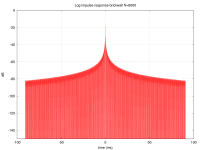
The frequency response plus some close-ups.
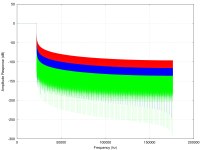
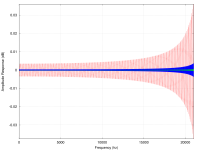
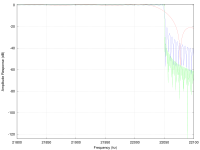
The corresponding FIR filter is the Fourier transform of that "rectangular pulse", so its coefficients are
c_i = 1/n* sinc(i/n) = 1/n* sin(pi* i/n)/(pi* i/n)
This FIR filter has infinite length and is not realizable. But we can look on how it "performs" if we truncate it.
But first some general observations ... it contradicts many of the early design criteria:
- It is very long.
- The log-Impulse response plot is relatively flat.
- It gets more and more brick wall
Some plots for n=8, fs=44100Hz, and only considering the coefficients i= -N/2...,N/2 for N=8,000 (red), N=80,000 (blue) and N=800,000 (green).
The log-squared-impulse response

The frequency response plus some close-ups.



Dear spzzzzkt,
Even though I am still unable to connect to my board to be able to try your filters I greatly appreciate your efforts and enjoy reading the evolution of your techniques and results. Hoping a PCI-e serial port adapter will finally allow me to update FW and filters.
I have been using the dbPOWERAMP upsampler to bypass much of the filter section (24/192) and this is without question very space inefficient.
Last weekend I was directed towards a site where there is 24/384 upsampler that one can use one track at a time before you decide you want to purchase the thing. http://samplerateconverter.com/
The software seems to be well regarded.
I tried a few tracks - not from the previously upsampled file but from the CD and thought I was hearing more atmosphere and less haziness - both of which could be saying more about dbpoweramp than this "new" software along with many other things that could be misleading me.
With full respect to your constraints of time I was wondering if you had compared what you are getting with your filters versus an upsampled file of 24/384?
I will post the address of the software mentioned later today. Do you think this could have any meaning? Is there a possibility of a reference of what the "perfect" filter would sound like? Curiosity FORCED me to write this.
Even though I am still unable to connect to my board to be able to try your filters I greatly appreciate your efforts and enjoy reading the evolution of your techniques and results. Hoping a PCI-e serial port adapter will finally allow me to update FW and filters.
I have been using the dbPOWERAMP upsampler to bypass much of the filter section (24/192) and this is without question very space inefficient.
Last weekend I was directed towards a site where there is 24/384 upsampler that one can use one track at a time before you decide you want to purchase the thing. http://samplerateconverter.com/
The software seems to be well regarded.
I tried a few tracks - not from the previously upsampled file but from the CD and thought I was hearing more atmosphere and less haziness - both of which could be saying more about dbpoweramp than this "new" software along with many other things that could be misleading me.
With full respect to your constraints of time I was wondering if you had compared what you are getting with your filters versus an upsampled file of 24/384?
I will post the address of the software mentioned later today. Do you think this could have any meaning? Is there a possibility of a reference of what the "perfect" filter would sound like? Curiosity FORCED me to write this.
Last edited:
- Home
- Source & Line
- Digital Line Level
- Filter brewing for the Soekris R2R
